Chapter: Modern Analytical Chemistry: Evaluating Analytical Data
The Distribution of Measurements and Results
The Distribution of
Measurements and Results
An analysis, particularly a quantitative analysis, is usually
performed on several replicate samples. How do we report the result for such an experiment when results
for the replicates are scattered around a central
value? To complicate matters fur- ther,
the analysis of each replicate usually requires multiple measurements that, themselves, are scattered around a central
value.
Consider, for example,
the data in Table 4.1 for the mass of a penny. Reporting
only the mean is insufficient because it fails
to indicate the uncertainty in measuring
a penny’s mass. Including the standard deviation, or other measure
of spread, pro- vides the necessary information about the uncertainty in measuring mass. Never-
theless, the central tendency and spread together
do not provide a definitive state- ment about a penny’s true mass. If you are not convinced that this is true, ask yourself how obtaining the mass of an additional penny will change
the mean and standard deviation.

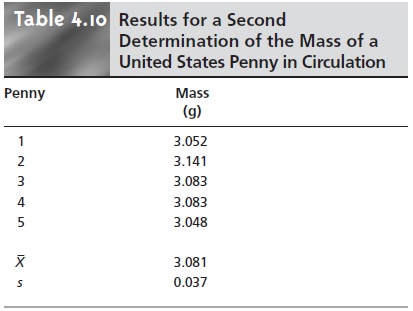
How we report
the result of an experiment is further complicated by the need to
compare the results
of different experiments. For example, Table 4.10 shows re-
sults for a second, independent experiment to determine
the mass of a U.S. penny
in circulation. Although
the results shown in Tables 4.1 and 4.10 are similar, they are
not identical; thus,
we are justified in asking whether
the results are
in agree- ment. Unfortunately, a definitive comparison between these two sets of data is not
possible based solely
on their respective means and standard deviations.
Developing a meaningful method for reporting an experiment’s result requires the ability to predict the true central value and true spread of the population under investigation from a limited sampling of that population. In this section we will take a quantitative look at how individual measurements and results are distributed around a central value.
Populations and Samples
In the previous
section we introduced the terms “population” and “sample” in the
context of reporting the result
of an experiment. Before continuing, we need to un-
derstand the difference between a population and a sample.
A population is the set of
all objects in the system
being investigated. These
objects, which also are mem- bers of the population, possess qualitative or quantitative characteristics, or values, that can be measured. If we analyze
every member of a population, we can deter- mine the population’s true central value,
μ, and spread, σ.
The probability of occurrence for a particular value, P(V),
is given as

where V is the
value of interest, M is the value’s
frequency of occurrence in the pop- ulation, and N is the size of the population. In determining the mass of a circulating United States penny, for instance, the members of the population are all United States pennies currently in circulation, while
the values are
the possible masses
that a penny may have.
In most circumstances, populations are so large that it is not feasible
to analyze every member
of the population. This is certainly
true for the population of circulating U.S. pennies. Instead, we select and
analyze a limited
subset, or sample, of
the popula- tion. The data in Tables
4.1 and 4.10, for example,
give results for two samples drawn
at random from the larger population of all U.S. pennies currently in circulation.
Probability Distributions for Populations
To predict the
properties of a population on the basis
of a sample, it is necessary to know something about the population’s
expected distribution around its central value. The distribution of a population can be represented by plotting the
frequency of occurrence of individual values
as a function of the
values themselves. Such
plots are called probability distributions. Unfortunately, we are
rarely able to calculate
the exact probability distribution for a chemical
system. In fact,
the probability dis- tribution can take any
shape, depending on the nature
of the chemical system being
investigated. Fortunately many chemical systems display one of several common
probability distributions. Two of these distributions, the binomial distribution and the normal distribution, are discussed next.
Binomial Distribution
The binomial distribution describes a population in which the values
are the number
of times a particular outcome
occurs during a fixed num- ber
of trials. Mathematically, the binomial distribution is given as

where P(X,N) is the probability that a given
outcome will occur
X
times during N trials, and p is the probability that the outcome
will occur in a single
trial.* If you flip
a coin five times, P(2,5) gives
the probability that two of the five trials will turn
up “heads.”
A binomial distribution has well-defined measures of central tendency and spread.
The true mean
value, for example, is given as
μ = Np
and the true spread is given by the variance

The binomial distribution describes a population whose members have only
certain, discrete values.
A good example of a population obeying
the binomial dis- tribution is the sampling
of homogeneous materials. As shown in Example 4.10, the
binomial distribution can
be used to calculate the
probability of finding
a particular isotope in a molecule.
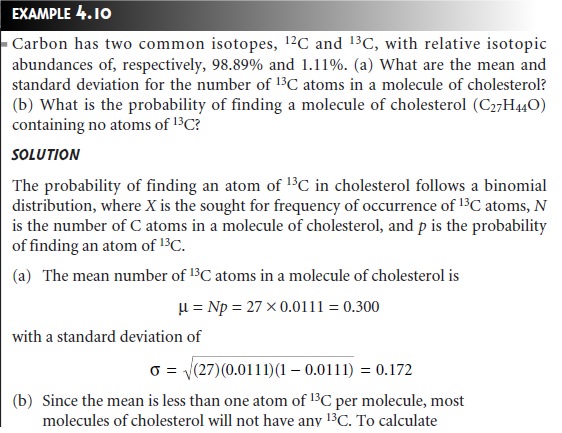
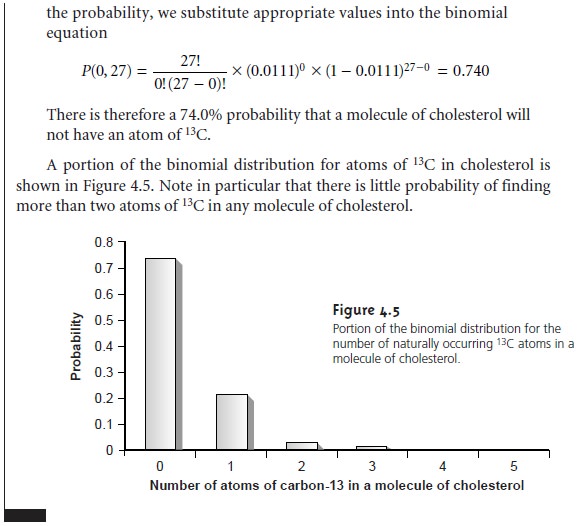
Normal Distribution
The binomial
distribution describes a population
whose members have only certain,
discrete values. This is the case with the number of 13C atoms in a molecule,
which must be an integer
number no greater
then the number of
carbon atoms in the molecule.
A molecule, for example, cannot have 2.5 atoms of 13C.
Other populations are considered continuous, in that members
of the popula- tion may take on any value.
The most commonly
encountered continuous distribution is the Gaussian,
or normal distribution, where the
frequency of occurrence for a value,
X, is given by

The shape of a normal
distribution is determined by two parameters, the first of which
is the population’s central, or true
mean value, μ, given as

where n is the
number of members
in the population. The second parameter is the
population’s variance, σ2, which is calculated using
the following equation*

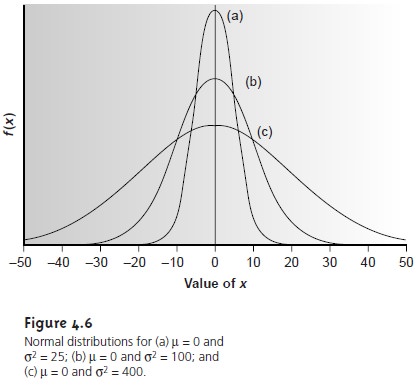
Examples of normal distributions with μ = 0 and σ2 = 25, 100 or 400, are shown in Figure 4.6. Several features of these normal distributions deserve atten- tion. First, note that each normal distribution contains a single maximum corre- sponding to μ and that the distribution is symmetrical about this value. Second, increasing the population’s variance increases the distribution’s spread while de- creasing its height. Finally, because the normal distribution depends solely on μ and σ2, the area, or probability of occurrence between any two limits defined in terms of these parameters is the same for all normal distribution curves. For ex- ample, 68.26% of the members in a normally distributed population have values within the range μ ±1σ, regardless of the actual values of μ and σ. As shown in Example 4.11, probability tables (Appendix 1A) can be used to determine the probability of occurrence between any defined limits.
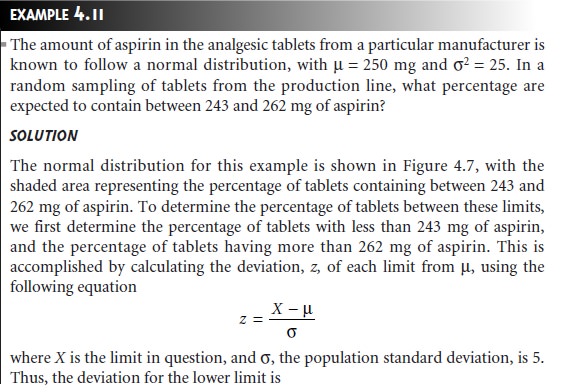
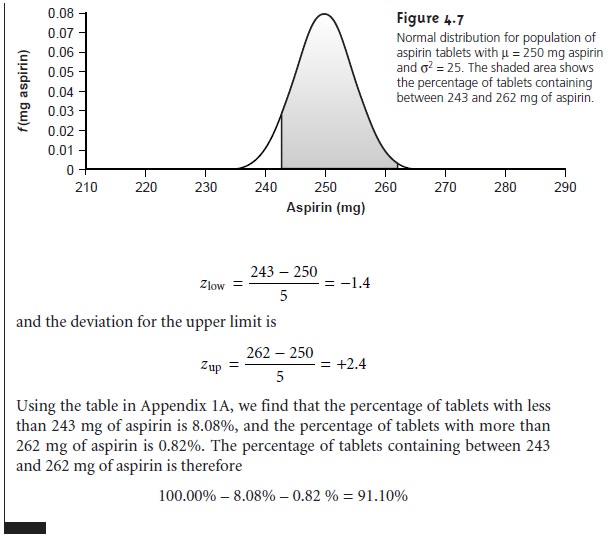
Confidence Intervals for Populations
If
we
randomly
select
a single
member from a pop- ulation, what will be its most likely value? This is an important question, and, in one
form or another, it is the fundamental problem for any analysis. One of the most important features of a population’s probability distribution is that it provides a way to answer this question.
Earlier we noted
that 68.26% of a normally distrib- uted population is found within
the range of μ ± 1σ. Stat- ing this another way, there is a 68.26% probability that a
member selected at random from a normally distributed
population will have a value
in the interval of μ ± 1σ. In
general, we can write
Xi = =μ± zσ
------------- 4.9
where the factor
z
accounts for the desired level
of confidence. Values
reported in this fashion
are called confidence intervals. Equation 4.9, for example, is the confidence interval for a single member of a population. Confidence intervals
can be quoted for any desired probability level, several examples of which are shown in Table 4.11. For reasons
that will be discussed
later, a 95% confidence interval
frequently is reported.
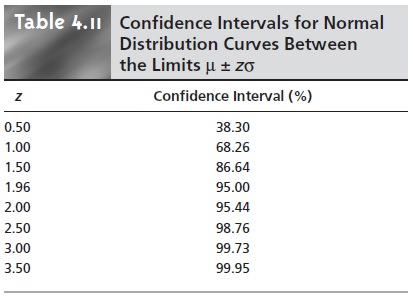
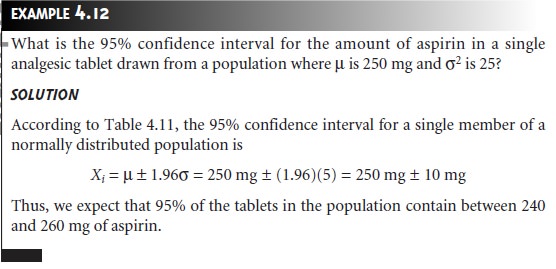
Alternatively, a confidence interval can be expressed in terms of the popula- tion’s standard deviation and the value of a single member drawn from the popu- lation. Thus, equation 4.9 can be rewritten as a confidence interval for the population mean
 4. 10
4. 10

Confidence intervals also can be reported using the mean for a
sample of size n, drawn from a population of known σ. The standard deviation
for the mean value, σx’, which also is known as the standard error of the mean,
is


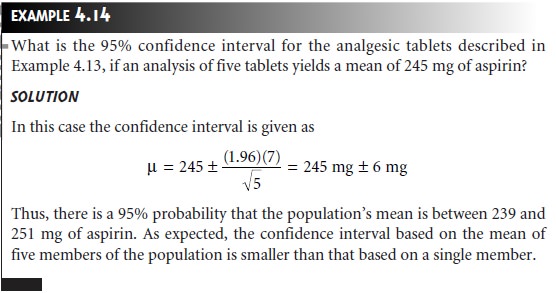
Probability Distributions for Samples
We introduced two
probability distributions commonly encoun- tered when studying populations. The construction of confidence intervals for a normally distributed population. We have yet to ad-
dress, however, how we can identify the probability distribution for a given
popula- tion. In Examples 4.11–4.14 we assumed
that the amount
of aspirin in analgesic
tablets is normally distributed. We are justified in asking how
this can be deter-
mined without analyzing every member of the population. When we cannot study the whole population, or when we cannot predict
the mathematical form of a popu-
lation’s probability distribution, we must deduce
the distribution from
a limited sampling of its members.
Sample Distributions and the Central Limit Theorem
Let’s return to the problem of determining a penny’s mass to
explore the relationship between a population’s
distribution and the distribution of samples drawn
from that population. The data shown in Tables 4.1 and 4.10 are insufficient for our purpose
because they are not
large enough to give a useful picture
of their respective probability distributions. A better
picture of the probability distribution requires a larger sample, such as that shown in Table 4.12, for which X– is 3.095 and s2 is 0.0012.
The data in Table 4.12 are best displayed as a histogram, in
which the fre- quency of occurrence for
equal intervals of data is plotted versus
the midpoint of each
interval. Table 4.13 and Figure
4.8 show a frequency table
and histogram for the
data in Table
4.12. Note that the histogram was constructed such that the mean
value for the data set is centered
within its interval.
In addition, a normal distribution curve using X– and s to estimate
μ and σ is superimposed on
the histogram.
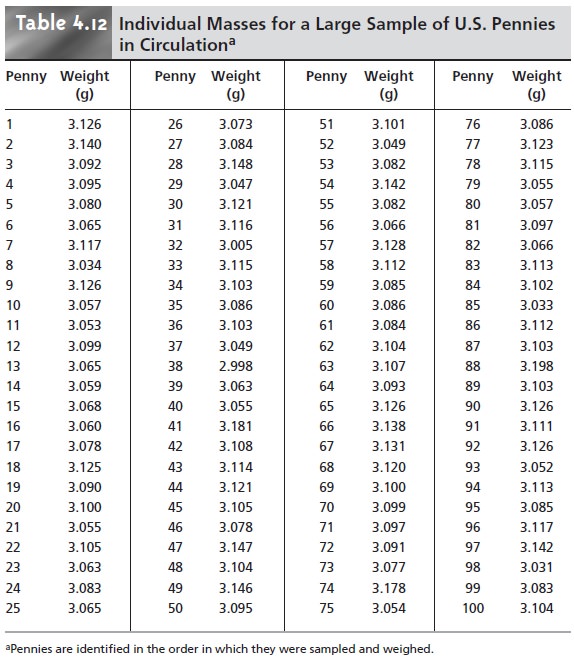
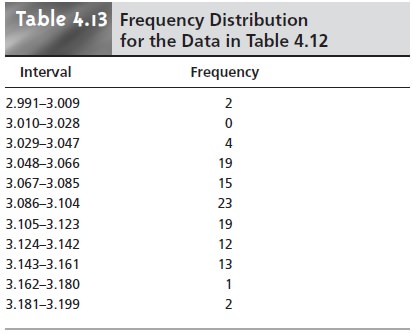
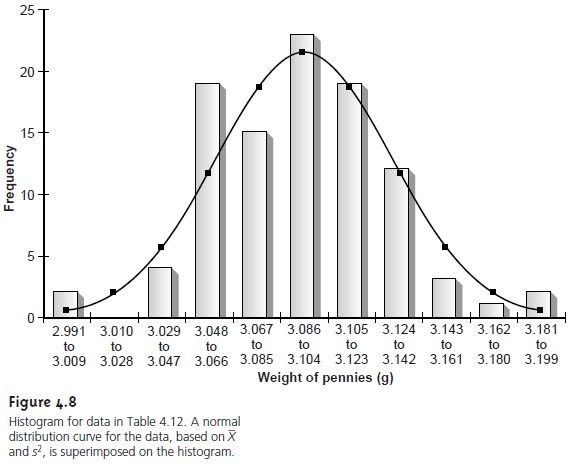
It is noteworthy that the histogram in Figure 4.8 approximates the normal dis- tribution curve. Although the histogram for the mass of pennies is not perfectly symmetrical, it is roughly symmetrical about the interval containing the greatest number of pennies. In addition, we know from Table 4.11 that 68.26%, 95.44%, and 99.73% of the members of a normally distributed population are within, re- spectively, ±1σ, ±2σ and ±3σ. If we assume that the mean value, 3.095 g, and the sample variance, 0.0012, are good approximations for μ and σ2, we find that 73%, 95%, and 100% of the pennies fall within these limits. It is easy to imagine that in- creasing the number of pennies in the sample will result in a histogram that even more closely approximates a normal distribution.
We will not offer a formal proof
that the sample
of pennies in Table 4.12 and
the population from which they were drawn
are normally distributed; how- ever, the evidence
we have seen strongly suggests
that this is true. Although
we cannot claim that
the results for
all analytical experiments are normally distrib- uted, in most cases
the data we collect in the laboratory are, in fact,
drawn from a normally distributed population. That
this is generally true is a consequence of the
central limit theorem.
According to this theorem, in systems subject
to a variety of indeterminate errors,
the distribution of results will
be approximately normal. Furthermore, as the number of contributing sources of indeterminate error increases, the results
come even closer
to approximating a normal distribu- tion. The central limit
theorem holds true even if the individual sources of in- determinate error are not normally distributed. The chief limitation to the central limit
theorem is that
the sources of indeterminate error
must be indepen- dent and of similar
magnitude so that no one source of error dominates the final
distribution.
Estimating μ and σ2
Our comparison of the histogram for the data
in Table 4.12 to a normal distribution assumes
that the sample’s mean, X–, and
variance, s2 , are appropriate
estimators of the population’s mean, μ, and variance, σ2. Why did we select X– and s2 , as opposed to other
possible measures of central tendency and spread? The explanation is simple; X– and s2 are considered unbiased
estimators of μ and σ2.If we could analyze
every possible sample
of equal size for a given popula- tion (e.g., every possible
sample of five pennies), calculating their respective means and
variances, the average
mean and the average variance
would equal μ and σ2. Al-
though X– and s2 for
any single sample probably will not be the same as μ or σ2 , they provide
a reasonable estimate for these values.
Degrees of Freedom
Unlike the population’s variance,
the variance of a sample in-
cludes the term n – 1 in the
denominator, where n is
the size of the sample
 4.12
4.12
Defining the sample’s
variance with a denominator of n, as in the case of the popu-
lation’s variance leads
to a biased estimation of x2. The denominators of the vari- ance equations 4.8 and 4.12 are commonly called
the degrees of freedom
for the population and the sample,
respectively. In the case of a population, the degrees of freedom is always equal
to the total number of members, n, in
the population. For the
sample’s variance, however,
substituting X for μ removes a degree of freedom
from the calculation. That is,
if there are
n
members in the
sample, the value
of the nth
member can always be deduced from the remaining n – 1 members and X–. For example, if we have a sample with five members, and we know
that four of the members a re 1, 2, 3, and 4, and that the mean is 3, then the fifth
member of the sample must be
(X– x n)– X1 – X2 – X3
– X4 = (3 x 5)–1–2–3–4=5
Confidence Intervals for Samples
Earlier we introduced the confidence interval
as a way to report
the most probable value for a population’s mean, μ, when the population’s standard deviation,
σ , is known. Since s2 is an unbiased estimator of σ 2, it should be possible to construct
confidence intervals for samples by replacing in equations 4.10 and 4.11 with s. Two complications arise, however. The first is that we cannot define
s2 for a single
member of a population. Consequently, equation 4.10 cannot be extended
to situa- tions in which s2 is used as an estimator of s2. In other
words, when e is unknown, we cannot construct a confidence interval
for μ by sampling only a single
member of the population.
The second complication is that the values of z shown in Table 4.11 are derived for a normal distribution curve that is a function of σ 2, not
s2.
Although s2 is an unbiased estimator of σ 2, the value
of s2 for any randomly selected
sample may differ significantly from σ2. To account
for the uncertainty in estimating σ 2, the term z in equation 4.11 is replaced
with the variable
t, where t is defined
such that t >= z at all
confidence levels. Thus,
equation 4.11 becomes
 4.13
4.13
Values for t at
the 95% confidence level are shown
in Table 4.14.
Note that t be- comes smaller as the
number of the
samples (or degrees
of freedom) increase, ap- proaching z as n approaches infinity. Additional values of t for
other confidence lev- els
can be found in Appendix
1B.
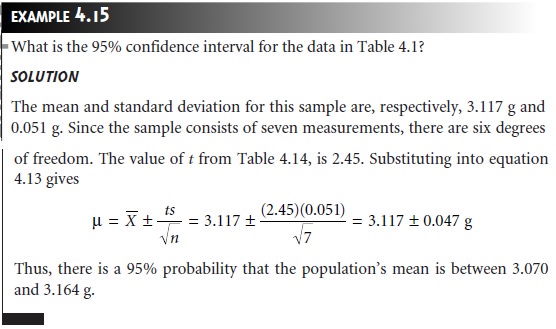
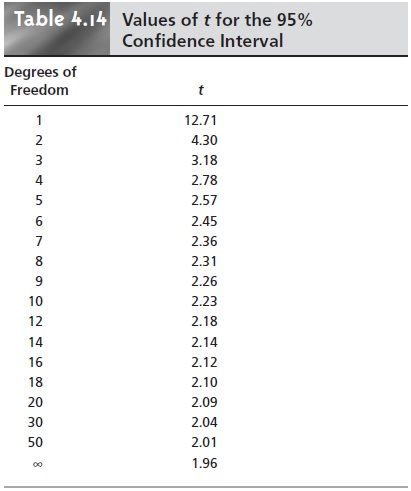
A Cautionary Statement
There is a temptation when analyzing data to plug numbers into an equation,
carry out the calculation, and report the result. This is never
a good idea, and you should
develop the habit of constantly reviewing and evaluating your data. For example, if analyzing five samples gives an analyte’s
mean concentration as 0.67 ppm with a standard deviation of 0.64
ppm, then the
95% confidence interval is

This confidence interval
states that the analyte’s true concentration lies within the range
of –0.16 ppm to 1.44 ppm. Including a negative concentration within the con- fidence interval should lead you to reevaluate your data or conclusions. On further
investigation your data may show that the standard deviation is larger than expected,
making the confidence interval too broad, or you may conclude that the analyte’s concentration is too small
to detect accurately.*
A second example
is also informative. When samples are obtained from a nor- mally distributed population, their
values must be random. If results for
several samples show a regular pattern
or trend, then the samples
cannot be normally
dis- tributed. This may reflect the fact that the underlying population is not normally
distributed, or it may indicate
the presence of a time-dependent determinate error. For example,
if we randomly select 20 pennies and find that the mass of each penny
exceeds that of the preceding penny, we might
suspect that the
balance on which the pennies are being
weighed is drifting out of calibration.
Related Topics